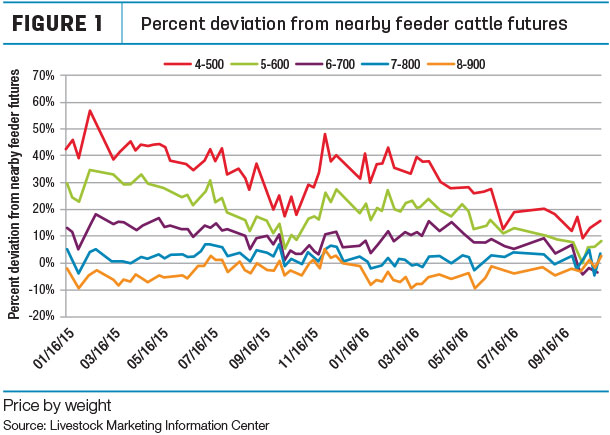Similarly, the difference between the cash price for cattle of a certain weight at a certain location and the nearby feeder cattle futures contract is known as the “basis.” The basis can be influenced by a variety of factors on both the demand side and the supply side.
In general, basis is influenced by location, weight, local conditions, time and quality. For example, in Mississippi the basis is currently very weak. Mississippi is far from most cattle feeders (location); feeder cattle supplies are at a seasonal high (time); and a large portion of the Southeast is in the middle of a severe drought that is limiting grass supplies (local conditions).
Each of those factors adds up to lower demand and higher supplies, and therefore a weak basis. At the same time, in Oklahoma there are many cattle feeders in nearby Kansas and Texas; conditions are relatively favorable with only 10 percent of the winter wheat currently rated poor or very poor; and stocker cattle operations are getting ready to put cattle out on the winter wheat pasture. As a result, the basis for feeder cattle is much stronger in Oklahoma City when compared to much of the southeastern U.S.
A main driver
The price slide is one of the main drivers of feeder cattle basis. One of the major driving forces for the price slide is the idea that buyers typically want cattle early and at lighter weights while cow-calf producers often want to sell cattle at heavier weights. Smaller cattle have more room for future growth, while most cow-calf producers have relatively inexpensive forages available for the cattle. This combination can push down prices for heavier cattle and inflate prices for lighter cattle. However, this also depends heavily on the environment surrounding both buyers and sellers.
For example, high corn prices can cause what is known as an “inverted price slide,” where lighter cattle are discounted relative to heavier cattle. Lighter cattle consume larger quantities of corn in the feedlot, making them expensive to feed when corn prices are high. Similarly, drought conditions can also cause lighter weight cattle to be priced lower due to a lack of grass or other forages that results in a larger supply of feeder cattle.
Possible implications
The feeder cattle price slide can have several implications for cattle producers. For stocker cattle producers, the level of profitability can be hinged on the cattle slide. A steeper slide can mean tighter margins as the price per hundredweight declines as the animal grows larger. A smaller price differential between lighter weight cattle and heavier cattle can present an opportunity for cattle buyers, assuming there are no major price fluctuations from the time the cattle are purchased to the time the cattle are sold.
As shown in the chart below, conditions are becoming increasingly favorable for cow-calf producers or stocker producers to grow animals to heavier weights.

The discount for heavier cattle has remained steady, while the premium for lighter cattle has shrunk considerably. This could present a buying opportunity for producers wanting to get into the stocker cattle business, particularly if combined with the use of risk management strategies such as hedging or purchasing a put option to limit downside price risk. ![]()

-
Brian Williams
- Assistant Extension Professor
- Mississippi State University
- Email Brian Williams
PHOTO: The feeder cattle basis is influenced by location, weight, local conditions, time and quality. Staff photo.






